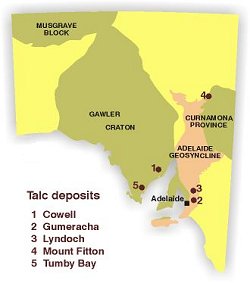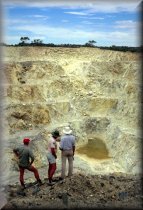 Talc is one of the most versatile and useful industrial minerals. It is a hydrous magnesium silicate (Mg3Si4O10(OH)2), the massive variety of which is known as steatite or soapstone. Talc is soft (1 on the Mohs scale of hardness), non-abrasive, inert and easily ground to a fine white powder used in many applications including:
Talc is one of the most versatile and useful industrial minerals. It is a hydrous magnesium silicate (Mg3Si4O10(OH)2), the massive variety of which is known as steatite or soapstone. Talc is soft (1 on the Mohs scale of hardness), non-abrasive, inert and easily ground to a fine white powder used in many applications including:
- paint manufacture, where oil absorption capacity, particle shape and colour (whiteness) are important properties
- paper industry, in controlling pitch in paper pulp, de-inking paper, and for paper filling and coating
- plastics industry, as a filler, particularly in polypropylene, polyester and nylon to improve dimensional stability, strength and heat resistance
- ceramics, in manufacture of tiles, sanitary ware, vitreous china and specialty ceramics such as electrical porcelain
- pharmaceutical and cosmetic applications, which require the brightest and purest grades of talc having good qualities of unctuosity and slip, and meeting rigid specifications for bacterial counts and chemical stability of fragrance oils.
Worldwide production of 7.4 Mtonne in 2013, large tonnages of the related mineral pyrophyllite (Al2Si4O10(OH)2), which has similar properties and substitutes for talc in some applications. Australian talc production of ~120 000 t/year is dominated by Western Australia from the world class Three Springs deposit. South Australian production totaled 4075 tonne in 2013.
South Australian deposits
Talc occurs in three main localities in South Australia — Mount Fitton in the northern Flinders Ranges, the Mount Lofty Ranges, and Eyre Peninsula. The Mount Fitton deposits are of a similar type as the Three Springs deposit in WA, the world’s second largest deposit. Generally the known deposits are small, with no resource estimates available. The Joes Hill deposit near Truro has a resource estimate of >500,000 tonne, though no grade is specified, and is likely to be low. Pockets of 70-75% talc have been observed.
Flinders and Mount Lofty Ranges
Mount Fitton deposits
These, the largest and highest grade of all the South Australian deposits, are located 130 km northeast of Leigh
Creek, and have been in continuous production since 1945. The leases have now been transferred from Normandy Industrial Minerals to Unimin Australia Ltd.
More than 40 individual deposits are known over an area of ~60 km2. Talc is hosted by the Adelaidean Balcanoona Formation, a pale grey dolomite and dolomitic marble unit with blue-grey algal limestone at the base. The formation is folded about east–west axes, and dolomite is coarsely recrystallised or silicified along faults or fractures striking parallel to the fold axes. Talc was formed by siliceous hydrothermal replacement in fold cores near the upper and lower contacts of the formation, and along adjacent faults and fractures. The larger deposits are generally 10–15 m wide, more than 20 m thick and several hundred metres long.
In 1997, Normandy Industrial Minerals temporarily ceased mining, and embarked on a 10-year program of re-screening and hand sorting ore from the large waste dumps which have accumulated over the 55 year mine life.

The following grades are produced:
- QS — super white paint grade (colour is the major criterion)
- J & J — pharmaceutical grade
- medium-grade coloured talc
- low-grade impure talc.
Recorded production from 1945 to 1999 totals 423 000 t. Production in 1999 was 8400 t.
Gumeracha deposits
Numerous small deposits have been worked in a 12 km long zone to the east of Gumeracha since 1901. The talc–albite bodies are irregular and discordant within Adelaidean metasediments of the Undalya Quartzite and Woolshed Flat Shale, having formed by metasomatic replacement of country rock in zones of shearing and brecciation. The in situ ore comprises 60–85% talc and 5–30% albite, with brown iron oxide impurity above the watertable and pyrite below. Laboratory testing during the late 1970s showed the talc–albite mixture to be suitable for refractory and ceramic uses.
Recorded production totals ~180 000 t, mostly of second and third grade talc. The major producers were Chapman, Torrens, Dunstan and Steatite Hill deposits. The only deposits currently in production are Chapman (~2000 t/year) and Forreston (~10 t/year).
Lyndoch deposits
Small lodes of coarse, flaky talc have been worked for second and third grades 5 km east-southeast of Lyndoch. The deposits are hosted by quartzite and bi-mica schist of the Woolshed Flat Shale and, like the Gumeracha deposits, are associated with albite. The lodes occur in strongly folded or faulted zones.
By far the largest and most productive of the deposits was at Tweedie Gully, which produced a total of 15 400 t. The last production was 464 t by Commercial Minerals Ltd in 1992. The leases have subsequently been relinquished and the workings rehabilitated.
Eyre Peninsula
Tumby Bay
The Tumby Bay talc deposits lie within two parallel northeasterly trending lines of lode over an area of 5 km2, 14 km northwest of Tumby Bay. The talc formed in alteration zones within isoclinally folded Katunga Dolomite of the Palaeoproterozoic Hutchison Group. Eight individual lodes have been defined within the eastern line of workings and four in the western. Principal contaminants are quartz, jasper, dolomite, graphite and kaolin.
Mining was almost continuous from 1910 to 1956, then intermittently until 1980. The total recorded production is 12 000 t, of which >10 000 t came from the eastern lodes. There are no current leases. A difficulty for future development may be the large number of collapsing underground workings.
Cowell
Small quantities of grey and green talc are mined for carving and ornamental purposes by Gemstone Corporation of Australia from a deposit hosted by Hutchison Group dolomite near Cowell.
Additional Reading
Conor, C.H.H. and Olliver, J.G., 1983. A review of the Gumeracha talc deposits, Mount Lofty Ranges. Mineral Resources Review, South Australia, 152:61-78.
Johnson, P.D., 1984. Talc deposits near Tumby Bay. Mineral Resources Review, South Australia, 154:60-68.
McCallum, W.S., 1990. Mount Fitton talc deposits. In: Hughes, F.E. (Ed.), Geology of the mineral deposits of Australia and Papua New Guinea. Australasian Institute of Mining and Metallurgy. Monograph Series, 14:1155-1157.
Scott, D.C., 1979. Tweedie Gully lodes; Lyndoch talc deposits. Mineral Resources Review, South Australia, 146:20-28.
Valentine, J.T., 1989. Industrial and non-metallic minerals — operations in South Australia. South Australia. Department of Mines and Energy. Report Book, 89/74:138-144.


